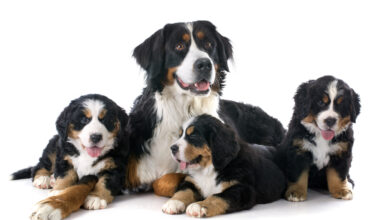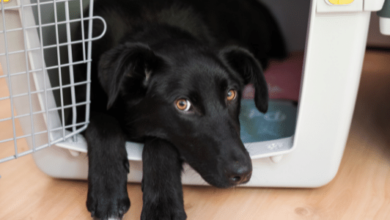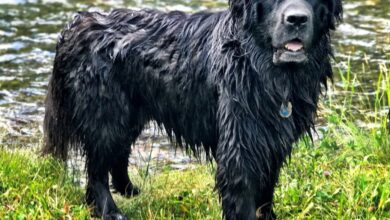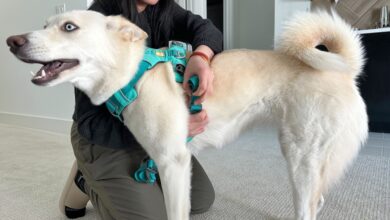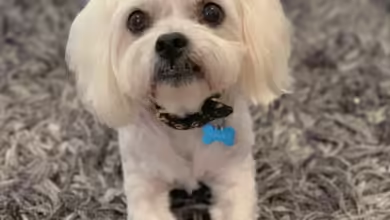A Complete Guide: Red Dog Breeds
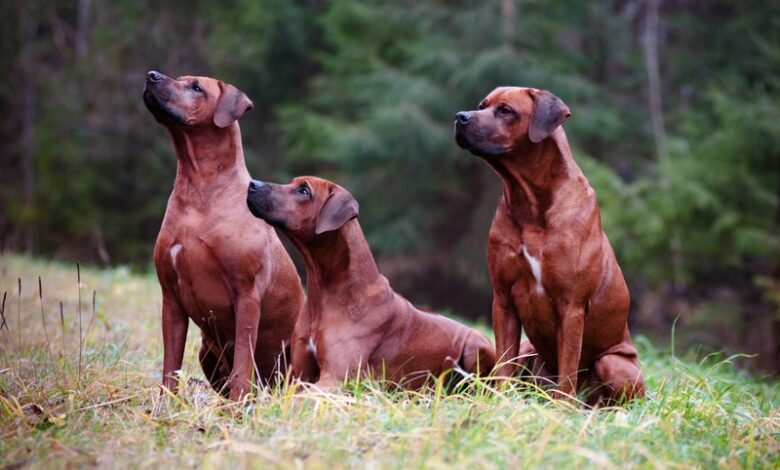
Red Dog Breeds Frequently Asked Questions (FAQ)
Now, we’ll provide answers to common questions asked about red dogs.
What dog breed is the red dog?
There is no single breed called a “red dog.” Many different purebred dog breeds can naturally occur with red coat colors, including Irish Setters, Golden Retrievers, Portuguese Water Dogs, Siberian Huskies, and more. The most recognizable red dog breeds have distinctive ginger, mahogany, chestnut, or copper-colored coats.
What is so special about the red dog?
Red pigmentation offers several advantages for dogs. Their fiery coats stand out visually, which aided ancestral breeds during hunting. Reds also provide excellent camouflage for stalking prey in brush or tall grass. The pigment that causes red coats, phaeomelanin, is more photostable than other colors. This means red hair is less prone to fading or graying with age. Genetically, red is a recessive trait meaning two copies are needed making naturally red dogs somewhat rarer.
Is a red fox a dog?
No, a red fox is most definitely not a breed of dog. Foxes belong to the genus Vulpes within the family Canidae but are a completely different species than domestic dogs. Foxes live in the wild and were never domesticated like wolves, who were the ancestors of modern dogs. Physically, foxes have longer muzzles, bushier tails, and pointed ears compared to dogs. Behaviorally, they retain their ancestral wild instincts rather than form deep bonds with humans.
Red-colored dogs have a special place in the hearts of many dog lovers. Their fiery coats stand out and catch the eye. We’ll explore the various red dog breeds and provide helpful information to home these beautiful canines. Whether you’re looking for a small lapdog or a large working breed, there’s sure to be a red dog that’s the perfect fit.
Little Red Dog Breeds
Some people prefer petite pups that can curl up in their lap. If you’re one who enjoys tiny dogs, several charming miniature breeds come in red.
Miniature Dachshund
The diminutive Dachshund was bred to hunt rabbits and other small game both above and below ground. Miniature Dachshunds weigh 11 lbs or less as adults. Their long, slender bodies allow them to wiggle into dens after prey. Red is a popular coat color for these small hounds. Mini Dachshunds are playful, lively companions but may bark excessively if not properly trained. Early socialization is important to curb any tendency towards aggressiveness.
Cavalier King Charles Spaniel
With their soft, silky locks and sweet facial expressions, Cavalier King Charles Spaniels easily win over fans. These toy dogs descend from the lapdogs of 17th-century British royalty. Reds are one of the six accepted coat colors for the Cavs. They have affectionate, gentle personalities and make wonderful family pets. Cavaliers require daily brushing to prevent matted coats. Screening is recommended to avoid serious inherited health problems in this breed.
Cocker Spaniel
While Cocker Spaniels are technically classed as sporting dogs due to their background in bird hunting, many today are kept simply as beloved pets. The American Cocker Spaniel version of this breed is usually quite small, with males standing around 15 inches and females slightly less. Beautiful chestnut red coats can have either wavy or curly textures. Cockers are highly intelligent and playful and form strong bonds with their humans. Daily exercise is needed to prevent behavioral issues.
Irish Terrier
Although larger than the previous breeds discussed, the feisty Irish Terrier is still a fairly small dog. Males are around 17 inches tall. Their most striking feature is the rich, deep copper coat. Underneath lies a tough, wiry outer layer and soft woolly undercoat. Irish Terriers are spirited, confident, and extremely loyal companions. Consistent training is required from an early age to curb any tendency to dominate family members. Daily brushing prevents matting. These sporting terriers enjoy rigorous physical and mental stimulation.
Real Red Dog
Now we’ll explore some medium-sized breeds with truly vibrant, recognizable red coats.
Vizsla
Originating in Hungary, Vizslas were bred as versatile hunting companions that could track, point, and retrieve games. Their short, dense coats come in chestnut red shades. These athletic dogs bond very closely with their humans through cooperative training. Vizslas have high exercise needs and thrive on interactive play, jogging, swimming, or canicross. Their intelligence and people-pleasing attitudes make them amenable to complex behaviors and dog sports. Regular brushing and conditioning prevent hair from matting.
Irish Red and White Setters
Larger than their Vizsla cousins, Irish Setters average around 25 inches tall. Their hallmark red and white markings contribute to their striking appearance. Originating on the Emerald Isle, these gundogs were developed to flush birds from cover and retrieve fallen game. Charming and energetic, Setters form deep friendships but require consistent leadership. Regular training challenges their powerful minds. Early socialization prevents a tendency to chase and nip at smaller animals. Long coats are low-maintenance with weekly brushing.
Nova Scotia Duck Tolling Retriever
This lively sporting breed gets its name from its heritage of luring waterfowl within gun range through playful motions. Tollers average 20 inches tall and weigh around 50 lbs as adults. Their distinctive ginger coats vary in shade from pale cream to deep red. These dogs are highly trainable, and their eagerness to please makes them compatible with many canine activities. Tollers bond tightly and do best in active homes where their intelligence and energy can be channeled through training, play, and physical activities like swimming or hiking.
Big Red Dogs Breed
For those seeking a larger companion, several imposing breeds boast fiery coats.
Irish Wolfhound
As the tallest of all dog breeds, Irish Wolfhounds tower over many people at an average height of over 32 inches. Their lanky frames can weigh up to 180 lbs yet have an almost delicate appearance. Reds occur naturally in this ancient Celtic hound breed that was used for hunting wolves in its homeland. Despite their massive size, Wolfhounds are gentle giants calm indoors once their energy needs are met. Daily walks allow these intelligent dogs to explore the outdoors in a controlled manner.
Great Dane
Equivalent in height though stockier than its Irish cousin, Great Danes rear up to shoulder heights over 30 inches. Known as the “Apollo of Dogs,” they were bred to hunt big game in Germany. Solid red coats complement their powerful, graceful physiques in a striking manner. Gentle temperaments make Danes affectionate family companions, yet training is required for them to understand their own bulk. Cardiac issues plague this giant breed, so responsible breeders conduct extensive health screenings.
Siberian Husky
Developed by the Chukchi people of Siberia to pull sleds across extreme terrain, Husky coats evolved to be highly insulating and weather-resistant. Reds, ranging from pale copper to deep mahogany, are one of several accepted solid coat pigmentations for this Northern breed. Mischievous yet devoted to their people, Huskies reach weights up to 60 lbs and stand 22 inches tall. High stamina and hunting instincts require careful socialization and daily mental/physical activity to curb any prey drive or destructive chewing. Regular brushing prevents shedding.
Long Red-Haired Dog Breeds
For owners seeking silky, flowing locks, these longer-coated dogs fill that niche proudly.
Irish Setter
More elongated in build than its Red and White cousin with deeper burnished coats, handsome Irish Setters rank amongst the most recognizable gun dog breeds worldwide. Distinctive liver chestnuts ranging from rich red to pale copper are hallmarks of purebred status. These agile canines move with an elegant hunter’s lope across fields, retrieving downed birds for their masters. Highly intelligent and outgoing, Setters demand firm, positive training from puppyhood alongside mental/physical challenges to fulfill their eager natures. Weekly brushing removes loose hair.
Weimaraners
Developed in Germany as all-around sport dogs for hunting large game, Weimaraners have refined silvery coats like spun steel. Reds come in coppery tones, often paling with age. Their long straight locks require regular brushing to prevent tangling. Weims form strong bonds with their human families through cooperative training sessions. Athletic yet sensitive, they need daily exercise and interactive play. Weimaraners also benefit from early socialization to help curb a natural prey drive if left unchanneled. These highly trainable dogs excel in obedience, agility, and field sports.
Belgian Shepherd (Tervuren)
One of four variants of the Belgian Shepherd breed, lithely built Tervurens have distinctive wiry gold-tinged mahogany coats flowing to ground length. Hailing from their namesake country, these herders were utilized to tend farm stock and protect property. Today they continue impressing in canine sports worldwide through intense trainability and powerful drive. Tervs bond intimately to handle human guidance. Consistent positive leadership is crucial due to a natural instinct to dominate if any uncertainty occurs in leadership. Regular brushing maintains healthy, shiny coats.
Chestnut Colored Dog Breeds
Nature also blessed several dedicated working dogs with gorgeous shades resembling Autumn leaves.
Golden Retriever
Famed the world over for their sunny temperaments, Golden Retrievers were developed in Scotland to aid hunters by fetching game unharmed from land and water. Their double-layer coats insulate against harsh climates and glimmer in warm shades varying from pale honey to deep chestnut hues due to recessive genes. Friendly, patient, and highly agile, Goldens are compatible family pets yet retain skills as versatile hunting companions. Weekly brushing removes loose coats and prevents mats from forming.
Labrador Retriever
America’s most popular purebred, the Labrador Retriever, originated on the island of Newfoundland as a hardworking gundog. Chestnut or ‘chocolate’ Labs showcase coats in rich hues ranging from milk chocolate to darker cocoa tints. Athletic yet gentle, these dogs form close bonds with people through cooperative activities like assistance, search & rescue, or competitive dog sports. Daily brushing keeps mats at bay in thick Lab coats, which shed heavily twice annually. Early socialization and obedience prevent destructive behaviors from developing.
Portuguese Water Dog
Ancient herding breeds from their namesake country, these dogs were developed to work livestock from boats as well as shorelines. Chestnuts showcase a range of warm, coppery shades. PWDs are highly trainable through positive reinforcement, which channels their tendency to dominate in controlled ways. Their dense water-repellent double coats require regular brushing to prevent matting. Beneath playful exteriors lie talents for tasks like animal handling through natural herding instincts. Early socialization ensures these agile canines bond closely to human families through interactive activities.
Red Hunting Dog Breeds
For owners wishing to hunt recreationally while bonding with their companion, several skilled gundogs stand out in vibrant reds.
English Setter
Closely related to its Irish and Red & White cousins, leanly muscled English Setters actively course the field on hunts pointing prey with elegant style. Coppery red coats ranging from pale copper to richer mahogany shades make them stand out in the brush and high grass. Highly trainable yet requiring extensive physical and mental challenges, these noble retrievers form deep attachments to their families through cooperative activities. Weekly grooming removes dead coat.
Brittany
Developed centuries ago in France, the hardworking Brittany breed has long hunted small game across varied terrain. Castaings demonstrate coats from pale golden red to richer oranges. Bold yet gentle companions, Brittanys possess outstanding trainability, which allows them to learn complex tasks from early puppy socialization. Their webbed feet enable walking through marshes and water in pursuit of prey to retrieve unharmed. Regular brushing keeps coats in good condition.
Gordon Setter
Distinguished by olive-brown coats flowing to their paws, elegant Gordons were initially bred for grouse hunting over rugged Scottish terrain. Dark coppery shades occur naturally within the breed standard. Majestic yet playful, these dogs bond tightly to handlers through daily exercise and obedience practice. Weekly brushing removes dead hair from their long locks. Skilled in locating and flushing prey, Gordons make dedicated hunting partners for their owners. Early socialization is key to preventing territorial behaviors.
Most Expensive Red Dog Breed
For those seeking an exclusive pedigree companion, a rare red dog may fit the bill.
Silver Dapple Dachshund
A novelty variety coated in unique piebald silver and red patches, these miniature show dogs fetch top prices at breeder auctions. Achieving full recognition in 2018, Silver Dapples currently commands $8,000-12,000. Intense scrutiny ensures health from top show bloodlines known for excellent conformation and lively temperaments. Pricing factors include championship titles, stud potential, and limited worldwide availability.
Irish Wolfhound (Show Champion Bloodline)
Originally bred solely for its namesake country’s Gaelic royalty, show quality rare-colored Wolfhounds command respect. Prize specimens from champion show kennels tracing directly to foundation bloodlines top $10,000-15,000. Buyers seek traits like proportional structure, refined Irish type, and deep red intensities infrequent in the breed. Strict contracts ensure puppies only go to approved homes suited to such a giant breed’s needs.
